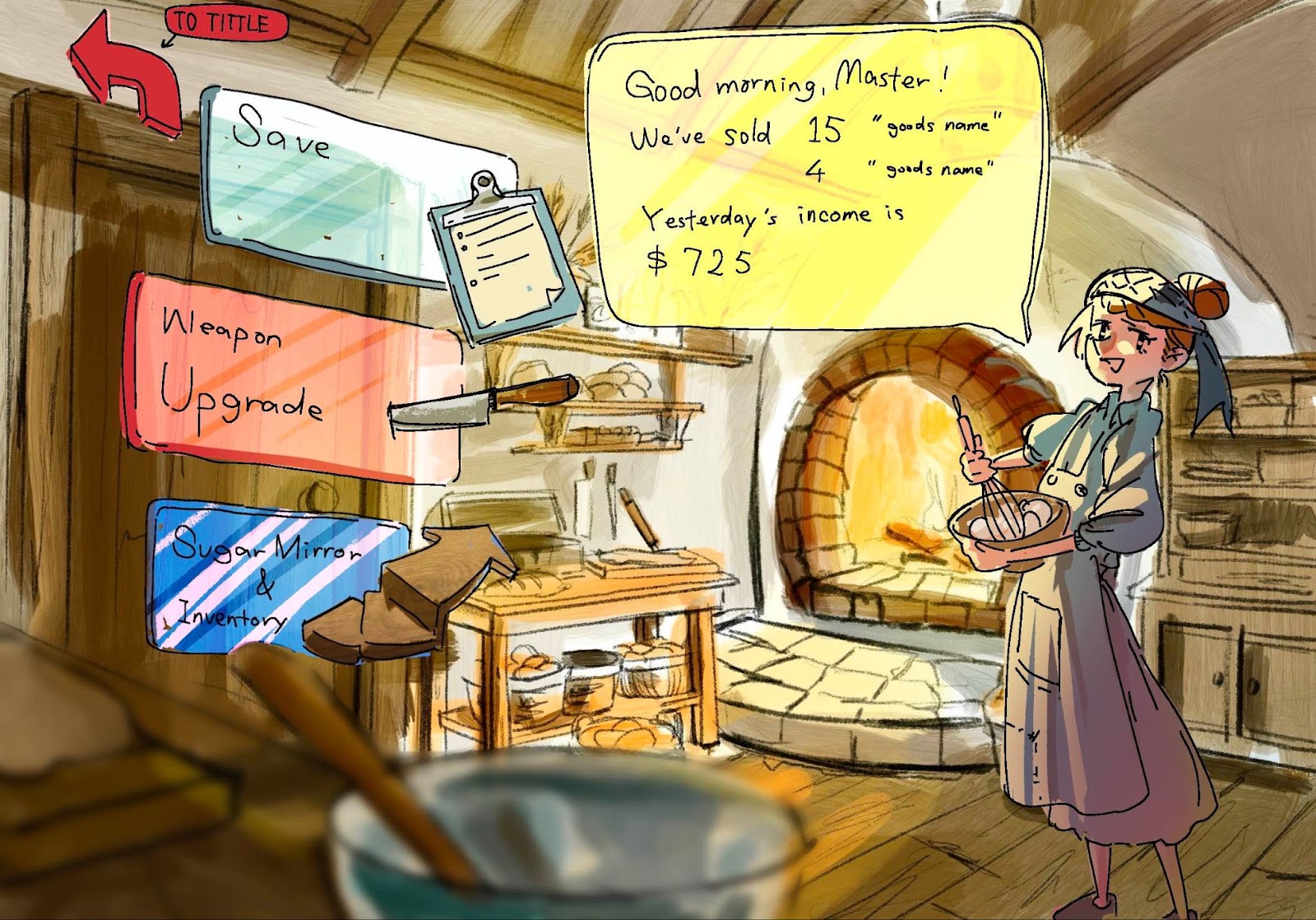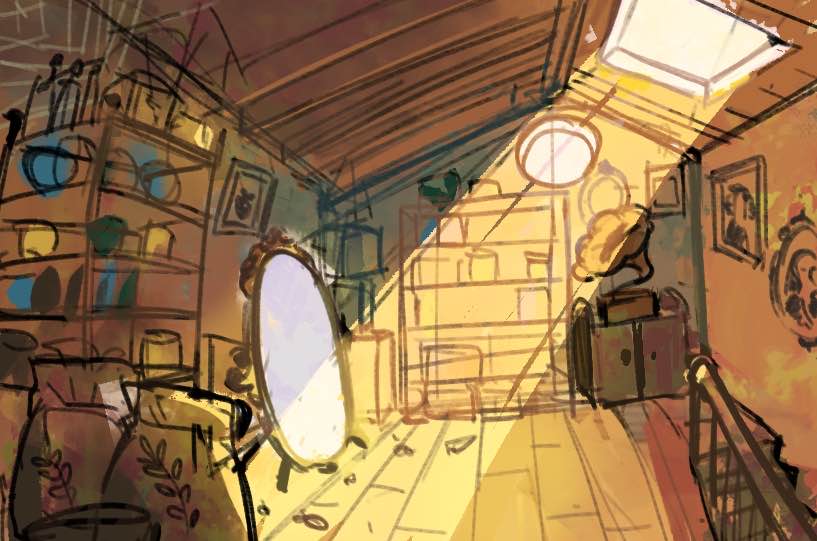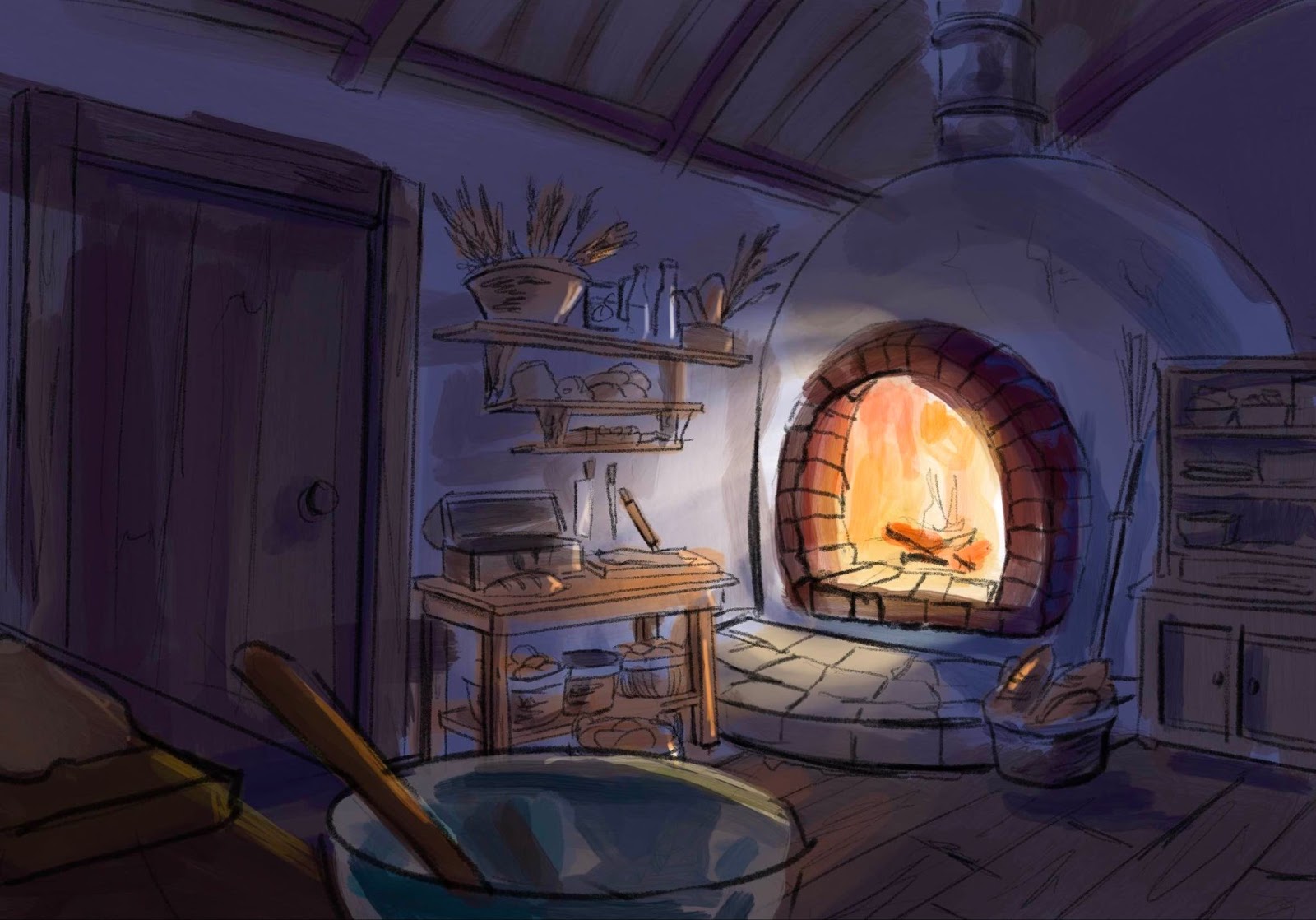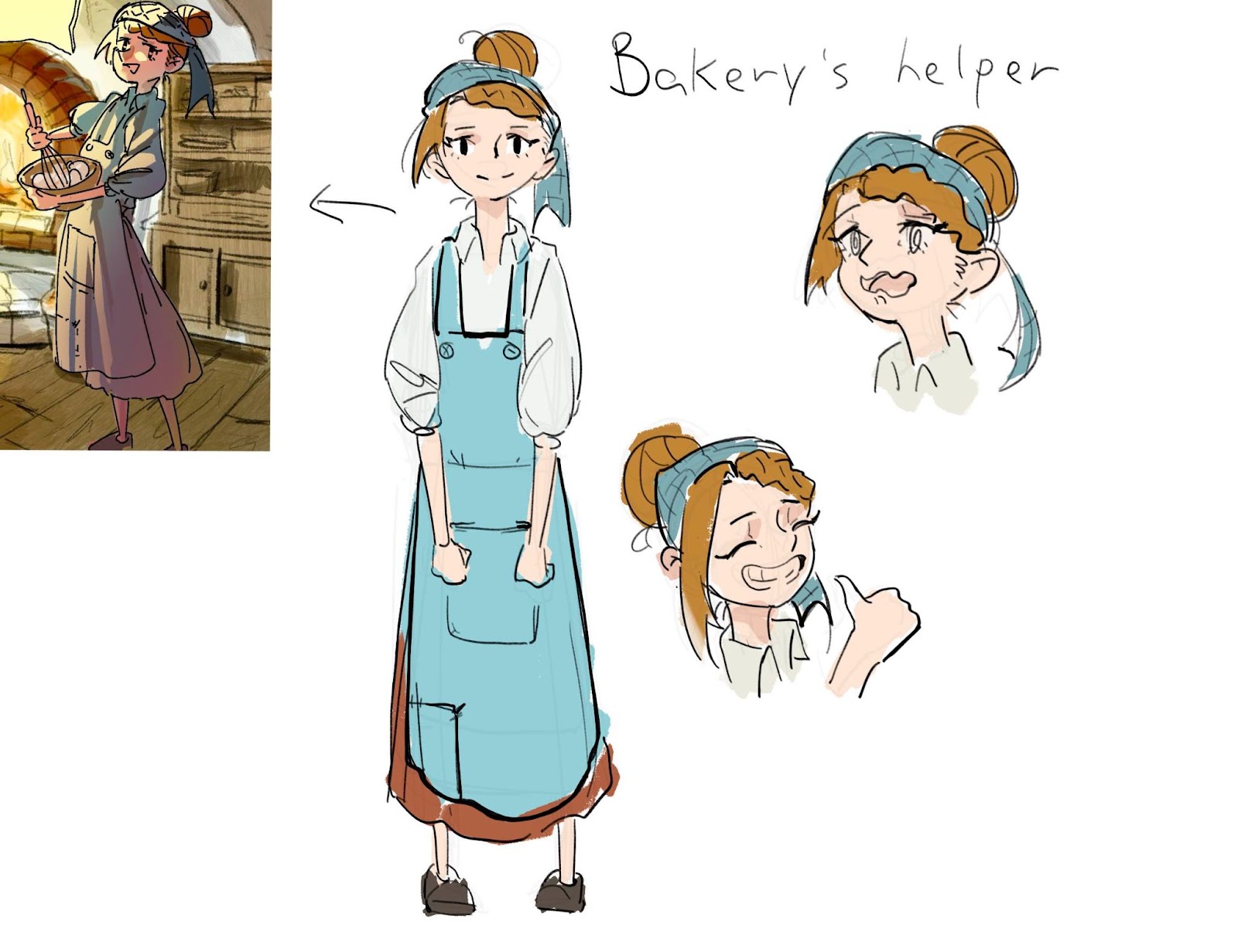Devlog 1 -- Creative Brief
Creative brief (February 16, 2025)
(written by Keera Hamasaki, Hailey San, and Alice Du)
Original Pitch
Kookd is a 2D fantasy adventure game set in a bakery, where the player fights against their environment. In Kookd, players take on the role of an aspiring pastry chef trying to keep their newly opened bakery from going under. Similar to Stardew Valley and Hades, the players struggle to pay rent and attract customers, they face the daily challenge of running a business with limited resources.
One night, everything changes when a mysterious mirror portal transports them to a realm filled with dessert-based monsters. In this world, ingredients aren’t simply bought—they must be fought for. Players will need to battle through different regions, defeating creatures and bosses to collect high-quality ingredients for their recipes.
Backstory
Our main character is a pastry chef with a newly opened bakery, but the unaffordable rent puts the shop at risk of shutting down. Until one fateful night, a mysterious mirror found in the bakery’s storage room lights up, turning into a portal that unexpectedly pulls them into a fantastical realm inhabited by dessert-based monsters.
Player’s Objective
The core objective of the game is to gather all necessary ingredients, explore every region, and ultimately defeat the final boss—all within a strict 30-day in-game time limit. Every decision the player makes during this period will determine the bakery’s fate. To succeed, players must carefully manage their time between two key tasks: running their bakery and venturing into the fantasy world to battle for ingredients. Exploring new areas will unlock rarer, higher-quality ingredients, but it also means facing increasingly difficult enemies and bosses. Meanwhile, back in the real world, players must purchase equipment, and keep customers satisfied to generate enough income to sustain the shop.
Brief Overview of Fantasy & Real World Mechanics
- Must plan and manage resources effectively to successfully run the shop
- Battle dessert monsters to get ingredients and other resources
- When a player dies from an enemy they return to the bakery
- Upgrade shop through purchasing items/upgrades and completing orders
- improve cooking efficiency, unlock new crafting options, and attract more customers
Enemies
- 3 found scattered across each map
- Drops common ingredients
- Varies depending on creature, e.g. Strawberries, wheat, and sugar cube
- 3x ingredient drops when defeated
Final Boss
⭑ Red tint around dessert creature sprint shows increased difficulty
- The ticket to saving the bakery once and for all
- The scale. A key component of the baking process, though it can be tricky to use effectively.
- By mastering this tricky aspect of baking, players can perfect their craft and expand their business successfully.
Combat
Dodging and Special Abilities: Use quick reflexes and unlockable abilities to evade enemy attacks or gain the upper hand. Kitchen Tools as Weapons: Equip culinary instruments like rolling pins and pastry bags, each with unique functions and upgrade paths
Weapon Variety:
- Rolling Pin: Short-range, upgradeable, capable of knocking back enemies and dealing more damage
- Pastry Piping Bag: Fires streams of icing or batter, can be upgraded to slow down enemies or deal area damage
- Spatula Shield: Block or deflect enemy attacks, providing a defensive option during combat ⭑ One new weapon gets introduced for every level
Exploration Features
Cookbook Navigation System – Functions as both a map and a guidebook. Each chapter represents a different region, highlighting objectives, unexplored areas, and key ingredients. Missing ingredients and incomplete recipes flash as reminders.
- Context-Sensitive Highlighting – Interactive objects shimmer or glow based on the equipped tool.
- E.g.: Overgrown vines (obstacle) glow green when the knife set is equipped, while frosted barriers shimmer blue when the pastry torch is selected.
- Energy Bar – Limited time to do certain tasks over the 30 days of the game (similar to Stardew Valley)
- Defeating dessert monsters will deplete energy level
- Can be replenished with food items ⭑ Once energy runs out the player is forced to return to real world
Boundaries
The player should have an energy bar or time limit similar to how Stardew Valley gives the player a certain amount of time in the day and energy to carry out any tasks they wish to do. In this case, the player would have a certain amount of time and energy to explore and collect ingredients in the food world before returning to the real world.
In the real world, monsters and bosses do not spawn. However, the character is able to bring back ingredients to the real world. This can be possible through a special item or bag to be used as the player’s inventory. In addition to that, the player cannot fight or pull-out weapons.
In the food world, the player cannot move on to the next day, or have access to the shop.
Not only that, but cooking tools are also used as weapons, and cookbooks are used for documentation and navigation purposes. Last but not least, another thing to note about the food world is that the monsters and bosses made out of food will attack the player. The enemy drops will be the source of ingredients
Envisioned Pre-game Development Sketches 



Concept Sketches: Yichang and Alice Du
Gameplay Demo (as of February 16, 2025)
Feedback from Iris
- The concept seems very ambitious, but there is potential in carrying out one level
- The game could benefit from emphasizing on the combat aspect in the food world, with less focus on the bakery aspect
- Combat and the food world seems to be more in depth compared to the shop
- Based on the UI: Running the shop should either lean towards an idle game model, or be left out entirely
- Limiting the number of checkpoints and making them secondary to the main objectives
- Another approach would be to direct attention to shop mechanics (not talking about the bakery shop) and how upgrading works.
Things To Consider/Question
- How many levels do you envision?
- Is there a way to lose the game if every day essentially works like a level? Is time really a challenge or just a game progression indicator?
- Do you choose in which world you are per day?
- How many enemy types do you plan on having?
- Do some enemies drop multiple types of items?
- If yes, is the drop rate percentage-based?
- How do you indicate some fights are more important than others?
- How many weapons do you envision?
- What does a boss fight look like?
- Does including the energy bar mean you can also replenish it like in Stardew Valley?
- If you are energy-limited, how does that affect combat exactly?
Changes Made After Receiving Feedback
Instead of having the character be able to move around freely in the shop/bakery, we could format the real world like a point and click menu. Another possibility would be to introduce an NPC whose purpose is to run the shop and bake while the player explores the food world. This way, the game would emphasize more on combat, and the player’s only reason to go back to the real world would be to fully replenish energy as the game moves on to the next day, as well as to drop off ingredients to the coworker NPC
There will be NO checkpoints in the food world. The player can eat items to replenish energy (e.g. fruit), but the only real checkpoint will be heading back to the real world for the rest of the day.
We can introduce the concept of a main quest, and reintroduce our scrapped idea of a 3 course meal. To do that, we first take into account Iris’ feedback, “Is there a way to really lose the game if every day essentially works like a level? Is time really a challenge or just a time progression indicator?” This would be taken into account by splitting up the 30 days into three levels, with each level lasting 10 days long. These levels would be labelled as appetizer, entree, and dessert. At the start of each level, the coworker will introduce a milestone of money to make before the deadline. For example, on day 1, if the coworker says you need to make $3000 by the end of day 10, that will be the goal for the first level. If the player fails to meet that goal, the game ends, resulting in a loss for the player.
Explaining The Levels
As mentioned, the game will have three levels: appetizer, entree, and dessert. Appetizer is the easy level, entree is medium, and dessert is the most difficult level.
Instead of having multiple worlds and multiple bosses, we narrow it down to one big map. Depending on what level the player is on, the strength and amount of HP the monsters have will vary. For example, on appetizer level, the monsters will have the least amount of HP and will be the easiest to defeat
For the purpose of saving time for this semester, there will be maybe 4-5 different variations of monsters in total with different drops and abilities. The only thing changing about them as the player progresses through each level is their combat difficulty (and maybe a red tint added to their character sprite as the levels become more challenging). For example, the same monsters from the appetizer level will be imported into the entree level, but they will just be more difficult to fight
To clarify, the words appetizer, entree and dessert do NOT mean new monsters or maps. They are simply labels to indicate which level the player is on
One boss to encounter during the dessert level. This will be the ticket to saving the bakery once and for all. The final boss can be the aforementioned monster possessing the boss in the real world, who caused the player to explore the food world and save the bakery in the first place. By defeating the final boss in the food world, the boss in the real world will not threaten to shut the bakery down anymore
Changes about Final Boss After Iris Feedback
- The final boss is based off of a measuring scale, typically used for cooking
- The boss attacks players by deploying groups of smaller enemies from a plate placed on top of its head. These enemies will be the same monsters fought in both the appetizer and entree levels
- There will be one round of fighting these enemies, deploying 9 enemies that the players will have to fight through.
- HP on the first stage depletes based off of how many monsters are on the plate
- Stage 2 involves the boss shooting beams at the player
- In this stage, the player will have to dodge the beams
- During this fight, there will be small windows of time where the player can attack the boss, depleting its health
- Once the boss’ HP reaches 0, the player wins the game
Upgrades
During feedback, Iris asked, “do upgrades subtract money you’re also making to save the shop?” To answer the question, yes. Upgrades should subtract the money also used to save the shop. This will encourage the player to think about their time and investments carefully as they progress through the 10 days of a certain level
Another question asked was, “how to upgrades Influence both combat and baking mechanics?” Since the weapons are cooking tools, The real world point and click menu can include a section for an upgrade shop. This shop can include normal cooking tools to buy. There would be a description of what the weapon can do, as well as a fun statement (e.g Piping bag: “The bread and butter of a baker! Food world: A long ranged weapon dealing 30 DMG).” To save time, the player cannot level up weapons to do more damage
In this upgrade shop, the player can also buy enhancements (e.g. faster speed or more dmg for a certain amount of time, healing items, and items that replenish energy (e.g. coffee)
Other Answers’ to Iris’ Questions
“How many levels do you envision?” The three levels: appetizer, entree and dessert
“Do you choose in which world you are in per day?” No. Although the player can travel back to the real world, it is only used to drop off ingredients, buy upgrades, and as a checkpoint moving on to the next day.
“How many types do you plan on having?” This can be further discussed, but some potential ideas are monster types that relate to ingredients you would use in baking. For example, a fruit monster, sugar monster, a whipped cream monster, etc.
“Do some enemies drop multiple types of items? If yes, is the drop rate percentage based?” Some monsters, like fruit monsters could drop fruit ingredients. To make things easier, the drops won’t be percentage based, and the monster will drop approximately 3 items upon being defeated
“How do you indicate some fights are more important than others?” As stated in the Explaining The Levels slide, we could have a red tint of colour go over the original character sprites to indicate they are more difficult to fight. Upon defeating these enemies, the monster could give double the amount of drops they’re originally meant to give
“How many weapons do you envision?” Possibly 3, with 1 of the 3 weapons being introduced as the player moves on to a new level
“What does a boss fight look like?” We could take inspiration from Undertale fights, where the player just has to move around to dodge attacks
“If you are energy-limited, how does that affect combat exactly?” Like stardew valley, defeating a monster will also take away a little bit of energy. The amount of energy can be shown on a side of the player’s screen
Get Kookd
Kookd
Explore and Fight to save your bakery!!
More posts
- Devlog 4 -- Final Assets74 days ago
- Devlog 3 -- Playtesting74 days ago
- Devlog 2 -- Process Work74 days ago

Leave a comment
Log in with itch.io to leave a comment.